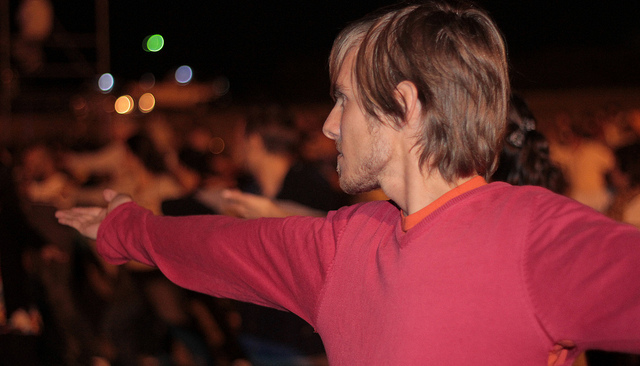In the June issue of Yoga Journal I noticed a blurb entitled, “Yoga Hybrids: Hit or Hype.”
The comments included as a response to YJ’s question were:
“Saw a profile boasting use of music with the F-bomb and no Sanskrit. That ain’t no yoga. Om namah Shivaya!” ~ Dorothy O.
“Who cares what you label it as long as people get up off the couch and move!” ~ Susan Redecke Yates
“Noooooo! I wish there were a clear differentiation between true yoga and yoga flavored exercise classes. One is a thousands of years old sacred practice, the other is a workout. Not the same thing, and most people wanting to try yoga have no idea how to distinguish between the real deal and copycats.” ~ Sarah Martyn
“Until you have experienced myriad movement forms, you’re only looking through a narrow door. Purists need to find humility, as much as the cynics touting ‘no mantras here.'” ~ Anne-Marie Lamonde
I found I could not stop mulling the YJ’s question and these answers over, even a week after I had read them. I had to ask myself; “Where do I fall on this issue and why?”
Clearly—particularly in terms of the way I teach and how I envision the future of yoga and my contribution to it—it’s an important, but increasingly complicated issue.
Let’s start at the beginning.
“Pure yoga,” or yoga as it was originally conceived, bears little resemblance to even the most “pure” forms of yoga we see today.
5,000 years ago, yoga wasn’t a system of movement, but a system of thought.
The first yogis had one asana—seated—in which they meditated as a way to achieve enlightenment. The addition of movement came thousands of years later, and its origins are still considered rather murky. So, if we’re going to get all hard nosed about it, I guess we’d better meet in a cave somewhere in India (well, you can meet there if you’re a guy, my estrogen levels are too high to have been allowed), slap on a loin cloth and smear yourselves in ashes, and we’ll consider you the “unsullied.”
The rest of us will have to come up with some kind of modern adaption if we want yoga to be a viable part of our lives. What does that mean? How far can or should we go? Is having a yoga “rave” legit? How about a yoga boxing class? Or aqua yoga? All things I have actually seen offered.
This is, of course, the question that Yoga Journal was asking in the first place.
Krishnamacharya, considered to be the father of modern yoga, understood and addressed this issue. He was the innovator who compiled the first cohesive and detailed series of asanas based on ancient texts as well as his own ideas to be used as a way to keep the body fit and able to do the seated meditation required for enlightenment. Had Krishnamacharya been a “purist” he never would have made those innovations at all.
The most strident defenders of “pure” yoga are undoubtedly the practitioners of Mysore, or self led Ashtanga, which is a set series of postures performed with no deviation, open with a chant and take place in a room with no music.
What I find interesting is that Mysore itself, which was developed by Krishnamacharya for the royals of Mysore in India during British occupation, draws not only from ancient yogic texts, but from British gymnastics.
The fact is, every form of yoga practiced today is a hybrid of some kind.
That being the case, are there degrees of hybridization that make some versions acceptable and others not? And if so, how do we determine what they are?
After grinding on this question for several days, knowing in my heart there was an answer—because I hate the idea of yoga being so dumbed down and diluted that it retains nothing of its fundamental wisdom and beauty—I decided this; I believe the answer lies in intent.
No matter what the form—because even walking can be yoga as long as we follow the primary guideline of “yoking together” the body and the breath in order to achieve mindfulness and ultimately the enlightening realization that all things are one—if the philosophic principle of yoga is being set forth in an authentic manner, that is good yoga.
On the other hand, no matter how intense the practice, how many chants are intoned, or how many sun salutations are ardently performed, if the intent is not in line with the philosophy, that is not good yoga.
Theoretically then, it is possible to have a “yoga rave” be just as true a practice as Mysore or Hatha or any other “traditional” style of practice—but is it as likely? Probably not.
What saddens me about the way yoga is often taught these days is not the introduction of music or Lululemon or no-Sanskrit allowed classes necessarily, but the unwillingness, or worse—the inability—of teachers to give students the gift of the knowledge of yogic ideals.
I was physically fit long before I knew what yoga was: it wasn’t the physical element that changed my life so dramatically for the better, it was the spiritual element. If no one had ever exposed me to it, I would be in the same sorry state I was before.
In this day and age particularly, when so many of us are lost, behaving cruelly and selfishly out of fear, are lonely or unfulfilled, yoga is a beacon of hope and possibility. In a perfect world, it would always be taught as a complete philosophy rather than just a way to get (our already beautiful bodies) bikini ready.
I’m expecting that many of you will disagree with my thoughts and encourage you to share your ideas with me here in the comments section. This is a subject which deserves attention and respectful debate.
For more on the origins of yoga, check out this wonderful article.
Love elephant and want to go steady?
Sign up for our (curated) daily and weekly newsletters!
Editor: Catherine Monkman
Photos: Tucker Sherman/Flickr, Jorge Macri/Flickr








Read 13 comments and reply